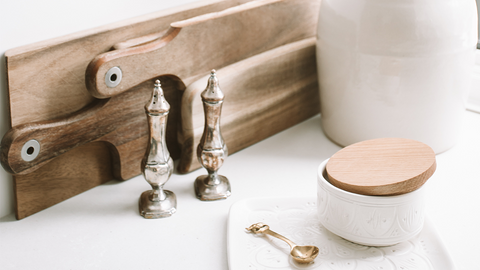Categories
- Cookware
- Bakeware
- Cutlery
- Coffee Machines and Accessories
- Smoked Cocktail and Food Tools
- Personal Care
- Wellness Mats
- Made In
- Kettles
- Greeting Cards
- Kikuichi Cutlery
- Marcato
- Smithey Ironware
- Cheese
- Funky Chunky
- Products of Scotland
- Meat N' Bone
- Millican Pecan
- Porter Road
- Xocolatl Small Batch Chocolates
- Heritage Steel
- Middleton Made Knives
- Diabetic Kitchen
- Chocolates
- Water Filtration Systems
- Copper State Forge
- Preparation, Organization & Storage
- Butcher Block/Cutting Boards
- Textiles, Towels and Aprons
- Fruit & Vegetable Tools
- Food
- Artisanal Spice Shop
- Brining, Basting & Roasting
- Tongs
- Cleaning & Sanitizing
- Spatulas & Turners
- Smoked Food Tools
- Ceramic & Glass
- Cheese Brothers
- Asheville Tea Company
- Coffee
- Specialty Tools
- Wine & Bar Accessories
- Seafood Tools
- Chocolates
- Coffee Makers
- Coffee & Tea Accessories
- Ladles, Whisks & Spoons
- Bitters & Mixers
- Grilling
- Measuring Cups & Spoons
- Serving Tools
- Zesters & Graters
- Coasters & Magnets
- Openers, Funnels & Strainers
- Oil & Vinegar
- Scales
- Temperature & Time
- Salt and Pepper Mills, Storage & Shakers
- Kitchen Appliances
- Bowls
- Flavoring & Food Coloring
- Vitamix
- Egg & Butter Tools
- Chef Apparel
- Anti-Fatigue Mats
- Jura
- Leather Accessories
Featured posts
Chu-Toro | Bluefin Tuna
Bluefin Tuna, also known as "Maguro" is prized around the world for its delicious umami flavors that are almost like butter. Chu-toro is the second most premium part of the Tuna, it is less marbled than O-Toro but offers a nice middle point between meat and fat.
Chu-Toro is often hard to find as there is less of it in every fish. Chutoro is the cut between the akami and otoro. This name is pertinent because “chuu” means middle in Japanese.
Our Tuna is wild-caught in the Pacific waters). It is 100% long line caught. We also get tuna some times of the year from Australia. It is not injected with any additives and is 100% natural.
Eating Raw? Our Master Sushi Chef says you should always tenderize Otoro and Chu-Toro with shallow cuts on each side to make it "melt away" with every bite.
O-Toro vs Chu-Toro?
The value of Tuna depends on its fat content (aka Marbling) just like a steak.
Chu-Toro is less marbled (meaning less fatty) but still superior to what you will find in most grocery stores and even most sushi restaurants which is called "Akami". Chutoro is the cut between the akami and otoro. This name is pertinent because “chuu” means middle in Japanese. It is also in the middle when it comes to fat content. Chutoro has a good mix of both fat and meat, which makes it less chewy than akami.
The most expensive and most desirable cut is otoro. This high-quality cut is from the fat under-belly of a tuna fish. The fat adds a sweet note to the taste and the texture is always described as “melt in your mouth” soft. Interestingly, this part of the tuna used to be thrown out before refrigeration was invented. The high fat content meant that it spoiled faster then the meatier parts. Nowadays, it is the most sought-after cut in every tuna.
Is This The #1 Tuna?
Like Red Meat Tuna is strictly graded, the highest grade is #01... but you can find Tuna that grades #2+, #2, and #3. The grade is meant to guide pricing and fairness and takes into account five factors: Appearance (how fresh does it look?), Size/Shape (Loin size), Color (looking for an exact degree of red in the bloodline and tail), Texture and Fat content.

Frozen?
This Tuna is flash frozen right after being harvested, meaning frozen at its peak of freshness, all of its flavor and nutrition, as well as its texture.
Thawing Instructions
Keep frozen until ready to use. Thaw slowly under refrigeration. Cook this naturally delicate product from a thawed state.
DO NOT leave soaking in water, it will affect the flavor and texture of the fish. DO NOT leave thawed-out fish in a vacuum-sealed bag for more than 24 hours. Consume within 24 hours for best results.
Is It Sushi-Grade?
There is no such thing as "sushi grade" or "sashimi grade" fish (more on our blog). However, this is as safe as raw fish gets from consumption. O-Toro is particularly eaten for sushi.






























































































